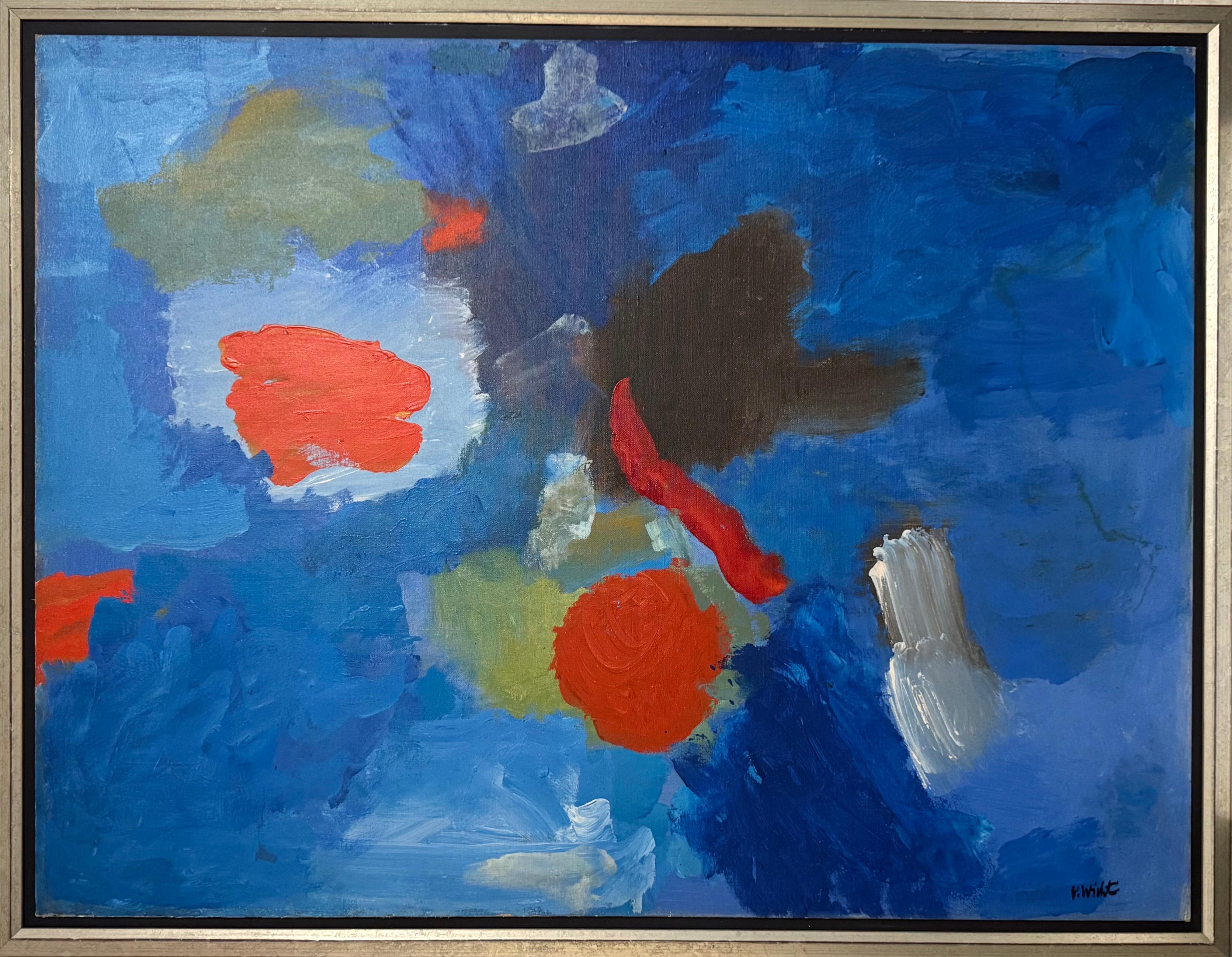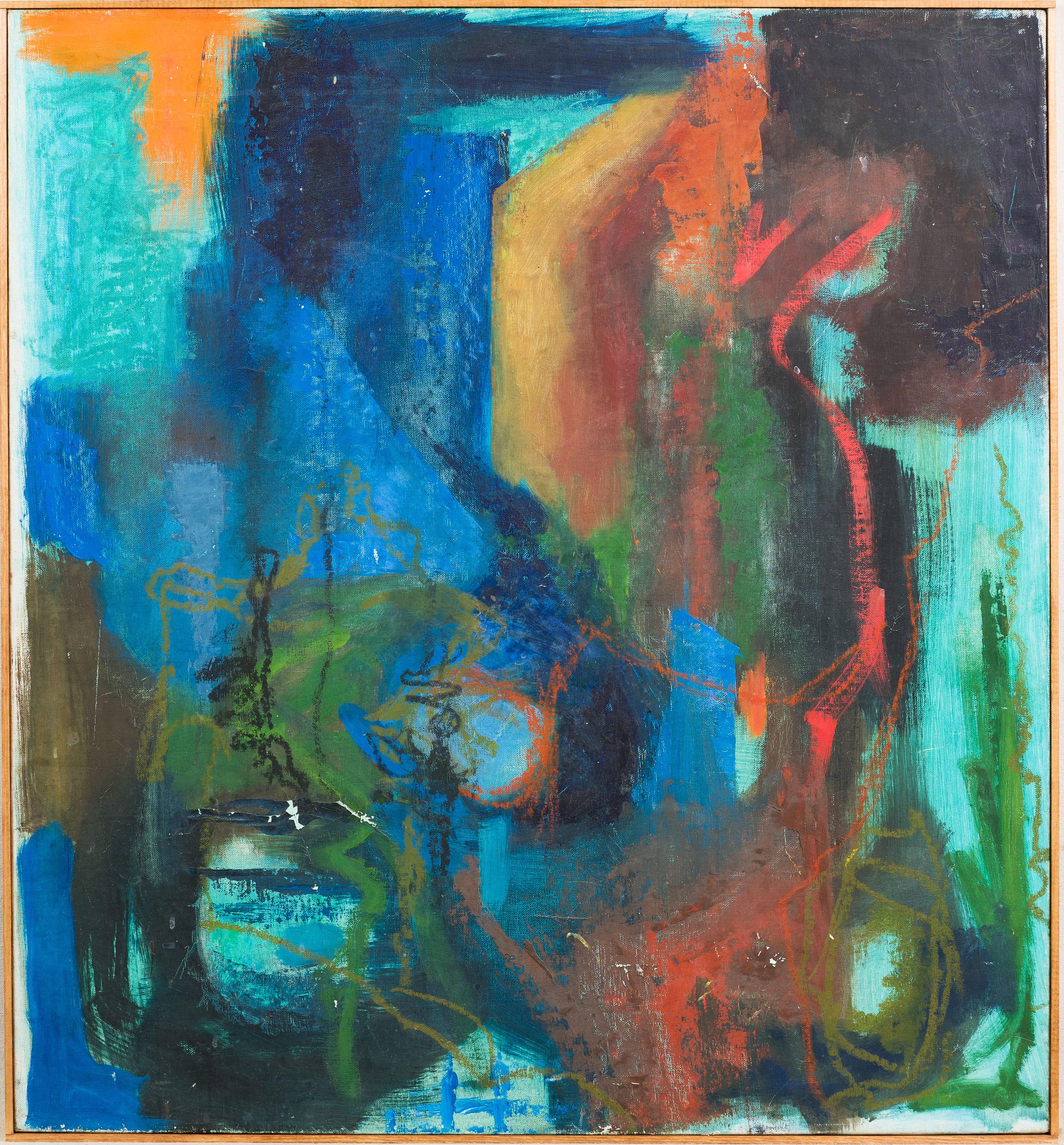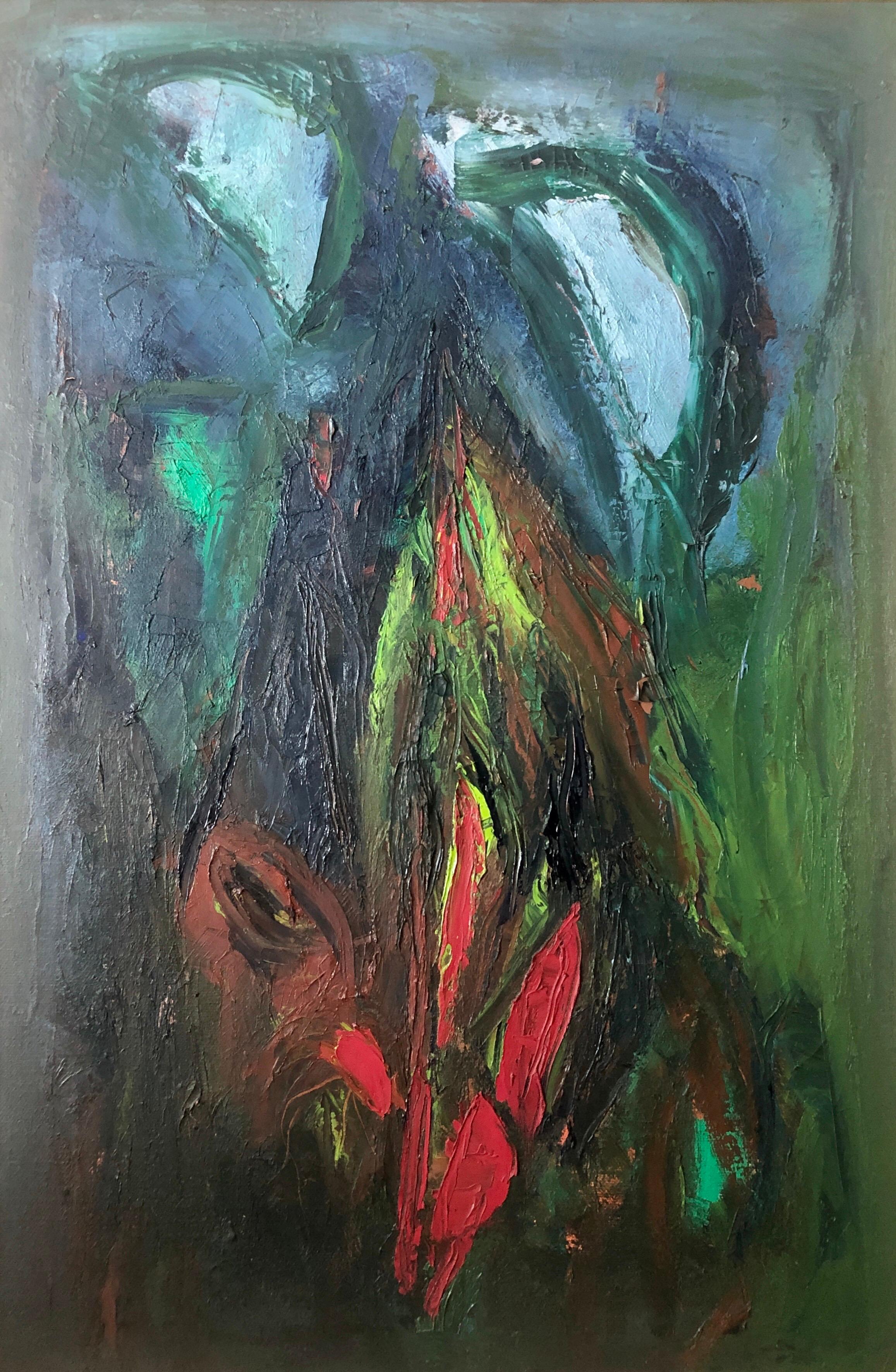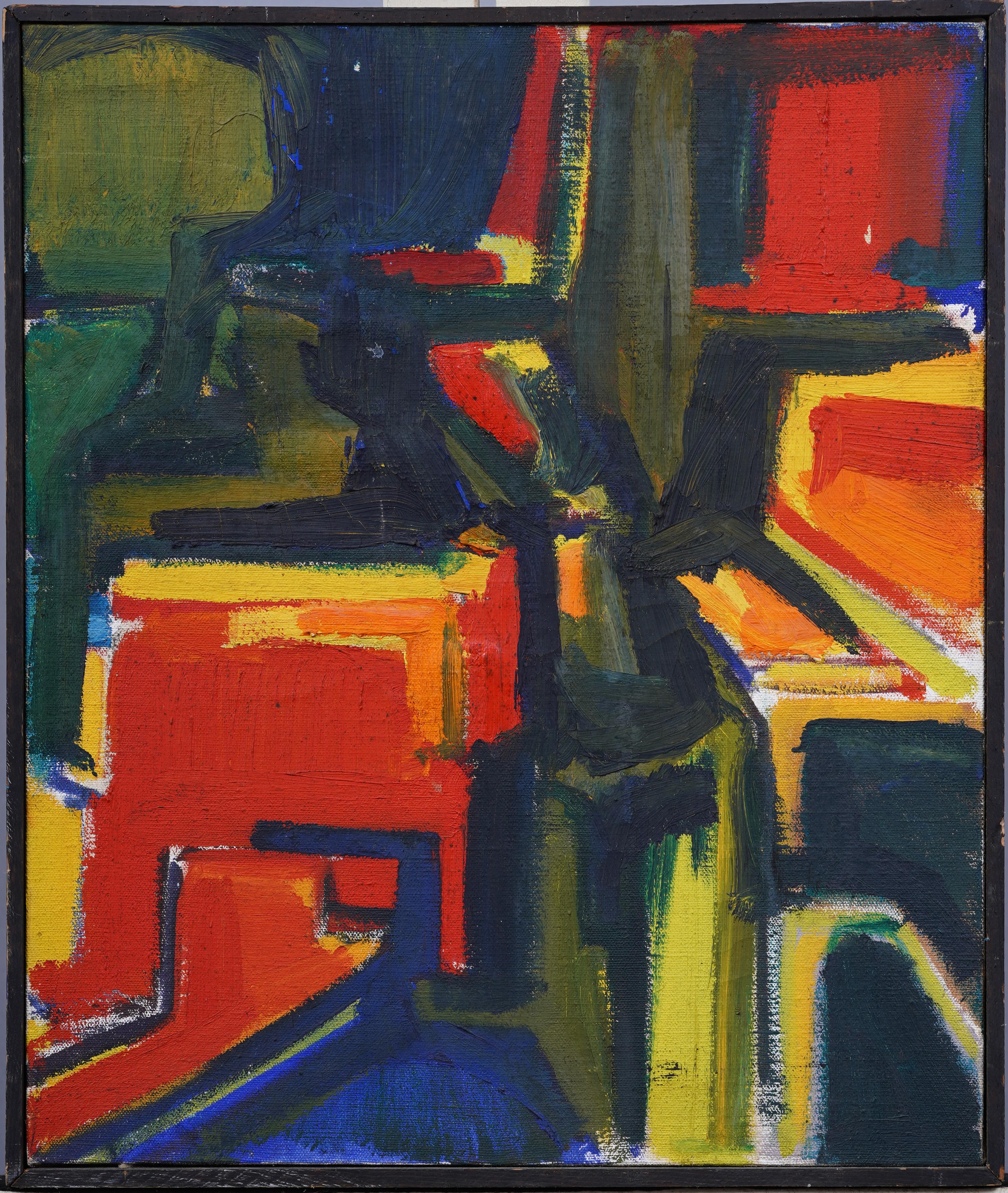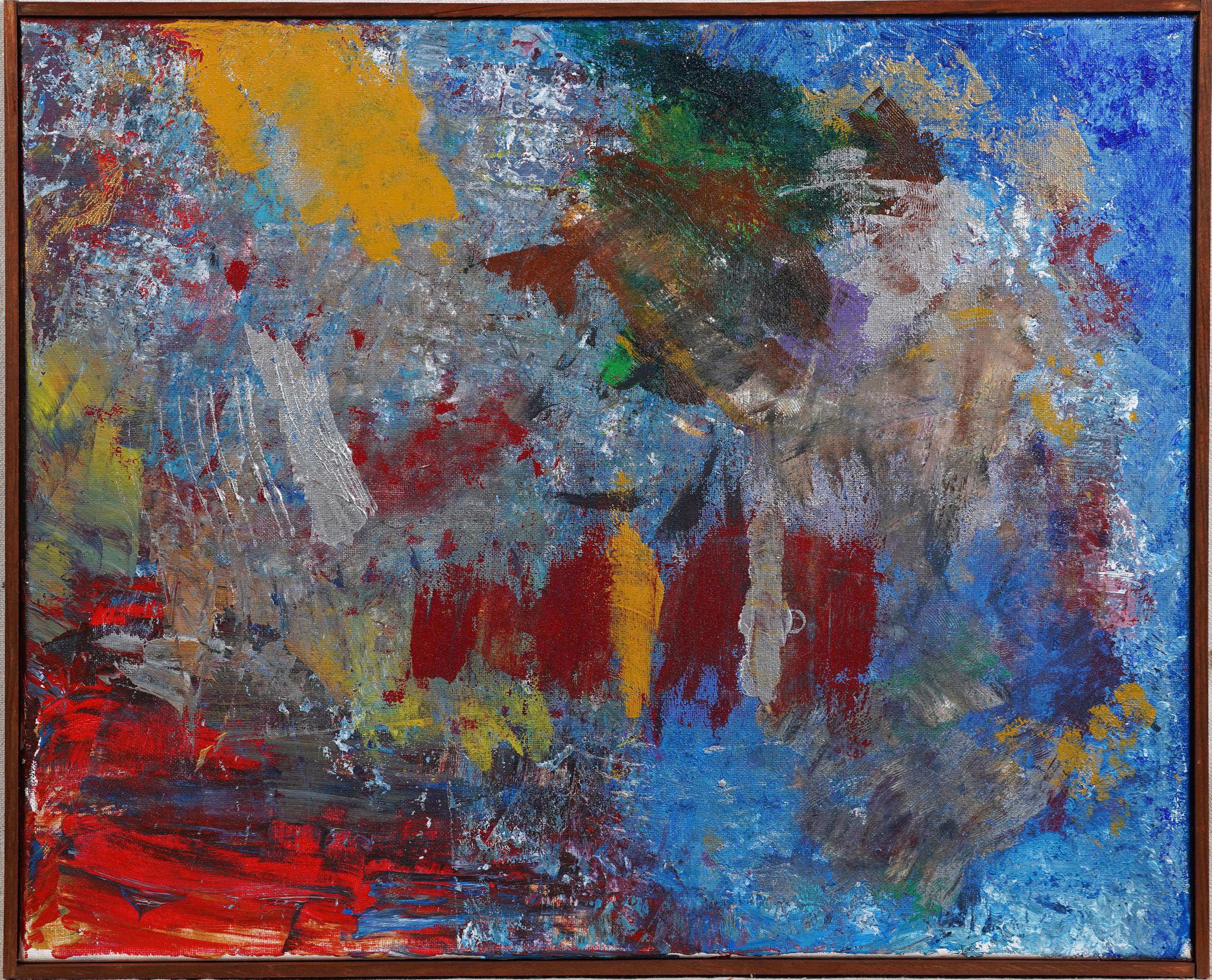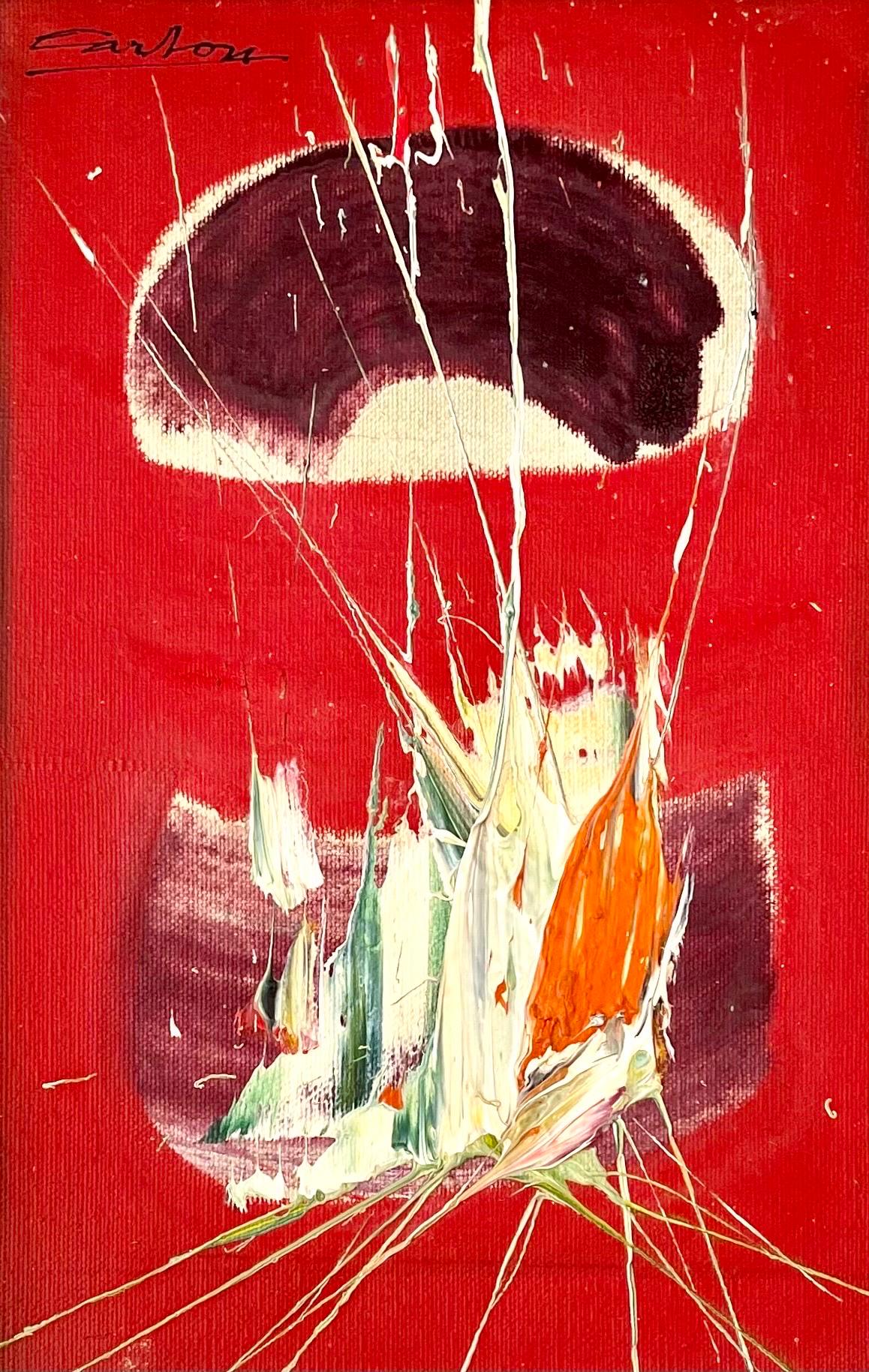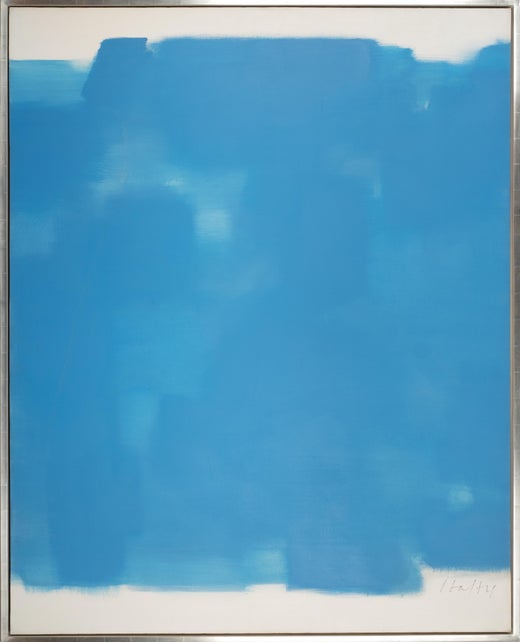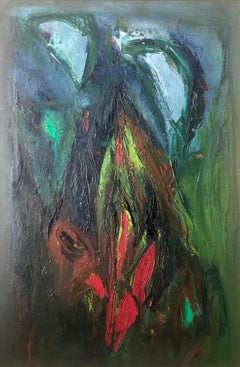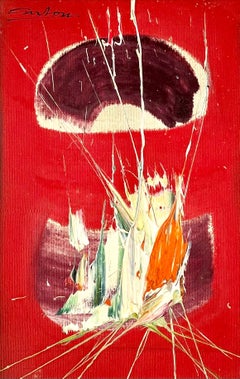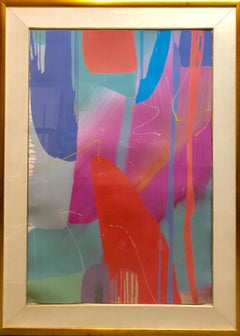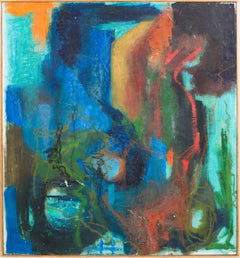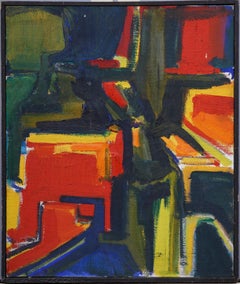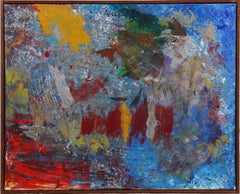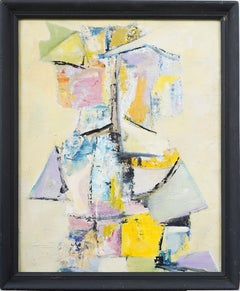Items Similar to Bold German American Abstract Expressionist Color Field Oil Painting Carl Holty
Want more images or videos?
Request additional images or videos from the seller
1 of 18
Carl HoltyBold German American Abstract Expressionist Color Field Oil Painting Carl Holty
$6,500
£4,932.99
€5,682.08
CA$9,288.56
A$10,194.10
CHF 5,257.38
MX$121,775.91
NOK 66,620.82
SEK 62,426.81
DKK 42,434.47
About the Item
Carl Robert Holty (American 1900-1973)
Abstract Expressionism Oil on Masonite board.
Abstract with greens blues and red,
Dimensions 12 x 9-1/2 inches. Framed 17 X 14 inches
Hand signed faintly in ink lower left Holty.
Provenance: Richard Norton Gallery (bears label verso)
Carl Robert Holty (1900–1973) was a German-born American abstract painter. Raised in Wisconsin, he was the first major abstract painter to gain notoriety from the state. Harold Rosenberg described Holty as "a figure of our art history," known for his use of color, shape and form.
Carl Holty was born in 1900 in Freiburg, Germany. Shortly after his birth, the family moved to Milwaukee, Wisconsin, where they lived in the German district with his grandparents. The Holty family then moved to the countryside near Green Bay where his father practiced medicine, before returning to Milwaukee around 1906. Holty's grandfather introduced him to art by taking him to visit local art galleries. Around the age of twelve, Holty began taking lessons with a local German painter. As a teenager, he started drawing cartoons and became interested in poster art. He attended Milwaukee University School, graduating high school within two and a half years. In 1919 he went to Marquette University, then joining the Reserve Officers' Training Corps during World War I, with the program ending within the same year. He enrolled at the Art Institute of Chicago, eventually attending classes at the Parsons School of Design. He returned to Milwaukee in 1923 and opened a portrait painting studio.
In 1925 Holty married and honeymooned in Europe, living there for the next ten years, first in Munich and then Switzerland. He moved to Paris that year, before returning to the United States in 1935 and living in New York City. He taught at Brooklyn College from 1950 until 1970. During that time he also was a visiting instructor at the Art Students League, Washington University in St. Louis, and University of Louisville. Upon his retirement from Brooklyn College he was awarded the title of professor emeritus.
In 1926, while living in Munich, Holty originally planned to attend the Royal Academy, only to train under Hans Hofmann. Hofmann's ideas about space, color, and shape would transform Holty's work, with Holty's work becoming more abstract as time went on.
From 1930 to 1935 he lived in Paris, exhibiting his work to good reception. There he met Robert Delaunay and Sonia Delaunay and joined Delaunay's group Abstraction-Création. His work was published in the group's magazine and became associated with Cubism and Neo-Plasticism. His Paris works have been compared to the paintings of Juan Gris and the synthetic Cubism of Pablo Picasso.
Upon returning to the United States, he found artist representation in New York City and became involved, once again, with Hans Hofmann and Vaclav Vytlacil as well as Stuart Davis, whom he had known in Paris. Vytlacil invited Holty to participate in discussions which led to the formation of the American Abstract Artists, which Holty would eventually come to chair, retaining his membership until 1944. During this time, he moved away from Cubism and started to experiment with Biomorphism. In the 1930s he used tape to give strong edges to forms, also reworking and overpainting sections, as seen in his work Gridiron (1943–1944). Between 1945 and 1948 he was represented by the Samuel M. Kootz Gallery. He continued to explore shapes and form, and by the 1960s contours had disappeared from his work, being replaced with subtle toned-down colors.
Holty served as artist in residence at Georgia State University, University of Florida, University of California at Berkeley, University of Wisconsin and the Corcoran School of Art. He also wrote a book, with Romare Bearden, titled The Painter's Mind, published in 1969.
In 1977 the Carl Holty Papers were donated to the Archives of American Art by Charles Byrne. On his role as a Wisconsin artist, Andrew Stevens stated in 1995 that "Holty's zeal for non-objective art was more closely identified with the younger group of American painters in the East. His artworks including his prints are among the first by a Wisconsin artist to come to grips with the tide of abstract art that spread from Europe to America at the beginning of the 20th century."
He was included in the portfolio of lithograph works; Various Artists, American Abstract Artists 1937 with Werner Drewes, Ilya Bolotowsky, Balcomb Greene, Ray Eames, Louis Schanker, Esphyr Slobodkina and Byron Browne.
Notable exhibitions
Carl Holty: The World Seen and Sensed, 1980–81; Milwaukee Art Museum
Annual Exhibition of Contemporary Painting, 1945; Whitney Museum of American Art
American Painting Today, 1950; Metropolitan Museum of Art
Abstract Painting and Sculpture in America, 1951; Museum of Modern Art
(Josef Albers, William Baziotes, Alexander Calder, Willem de Kooning, Philip Guston, Marsden Hartley, Jackson Pollock, Isamu Noguchi and Man Ray.)
Contemporary American Painting and Sculpture, 1963; Krannert Art Museum
- Creator:Carl Holty (1900 - 1973, American)
- Dimensions:Height: 17 in (43.18 cm)Width: 14 in (35.56 cm)
- Medium:
- Movement & Style:
- Period:
- Condition:
- Gallery Location:Surfside, FL
- Reference Number:1stDibs: LU38212877782
Carl Holty
Born in Freiburg, Germany, Carl Holty moved with his parents to a Germain community in Milwaukee when he was an infant. He began studying art at the Milwaukee Normal School under instructors who had trained in Europe and later continued his studies at the Art Institute of Chicago. In 1919, following a summer at an artists' colony in Saugatuck, Michigan, Holty enrolled at Parsons School of Design and the National Academy of Design, both in New York. He briefly considering entering medical school, his father’s profession, though with the help of his grandfather, returned to Germany to continue his art education. It was at Hans Hofman’s school that Holty would be introduced to the principles of modernist composition and ideas in painting and drawing, an influence he would consider his main focus throughout his career. Hofmann "first opened my eyes to the plastic nature of drawing." Holty once recalled. Displaying no interest in the predominant style of expressionism, popular in Germany at the time, Holty focused on the tenants of Cubism, Fauvism, and Futurism which lead him, in 1928, to relocate to Paris. Holty quickly became part of the active artistic community in the nation’s capital associating with many of the major figures of international avant-garde art including Miro, Mondrian, Arp, and Delaunay, the latter of which sponsored Holty to become one of only two American members of the Abstraction-Creation group founded by Theo Van Doesburg. Holty returned to America in 1936 becoming a significant figure in the development of abstract art. He reconnected with his old mentor Hans Hofmann and developed friendships with many of the City’s rising artist’s including Vaclav Vytlacil whom he had known in Paris. It was this group that formed the American Abstract Artists association, where Holty would serve as chairman in 1938 and with whom he’d exhibit with through 1944. It was during this period Holty abandoned Cubism for Biomorphism, leaving behind edges to explore shapes and forms that ultimately lead to his color field paintings of the mid 1950s and through the remainder of his career.
About the Seller
4.9
Platinum Seller
Premium sellers with a 4.7+ rating and 24-hour response times
Established in 1995
1stDibs seller since 2014
1,819 sales on 1stDibs
Typical response time: 1 hour
- ShippingRetrieving quote...Shipping from: Surfside, FL
- Return Policy
Authenticity Guarantee
In the unlikely event there’s an issue with an item’s authenticity, contact us within 1 year for a full refund. DetailsMoney-Back Guarantee
If your item is not as described, is damaged in transit, or does not arrive, contact us within 7 days for a full refund. Details24-Hour Cancellation
You have a 24-hour grace period in which to reconsider your purchase, with no questions asked.Vetted Professional Sellers
Our world-class sellers must adhere to strict standards for service and quality, maintaining the integrity of our listings.Price-Match Guarantee
If you find that a seller listed the same item for a lower price elsewhere, we’ll match it.Trusted Global Delivery
Our best-in-class carrier network provides specialized shipping options worldwide, including custom delivery.More From This Seller
View AllLarge Abstract Expressionist Oil Painting on Canvas John Von Wicht WPA Artist
Located in Surfside, FL
John von Wicht (German American, 1888-1970)
"On Blue"
1964
Oil and acrylic on canvas
Hand signed lower right "V. Wicht",
Hand signed, titled, and dated on the stretcher "1964-66"
D...
Category
1960s Abstract Expressionist Abstract Paintings
Materials
Oil, Canvas, Acrylic
Large Colorful MCM Abstract Expressionist Oil Painting Modernist Ralph Rosenborg
By Ralph Rosenborg
Located in Surfside, FL
Ralph Rosenborg (American, 1913-1992) Mountain Weed with Two Clouds, oil on jute canvas, canvas is hand signed recto and verso, artists label and Snyder Fine Art gallery label, The p...
Category
1960s Abstract Expressionist Abstract Paintings
Materials
Canvas, Jute, Oil
American Vivid Abstract Expressionist Art Oil Painting Norman Carton, WPA Artist
By Norman Carton
Located in Surfside, FL
Norman Carton (1908 – 1980) was an American artist and educator known for abstract expressionist art. He was born in the Ukraine region of Imperial Russia and moved to the United States in 1922 where he spent most of his adult life.
A classically trained portrait and landscape artist, Carton also worked as a drafter, newspaper illustrator, muralist, theater set designer, photographer, and fabric designer and spent most of his mature life as an art educator. Carton showed in and continues to be shown in many solo and group exhibitions. His work is included in numerous museums and private collections throughout the world.
Norman Carton was born in the Dnieper Ukraine territory of the Russian Empire in 1908. Escaping the turbulence of civil war massacres, he settled in Philadelphia in 1922 after years of constant flight. While attending the Pennsylvania Museum School of Industrial Art, Carton worked as a newspaper artist for the Philadelphia Record from 1928 to 1930 in the company of other illustrator/artists who had founded the Ashcan School, the beginnings of modern American art. From 1930 to 1935, he studied at the Pennsylvania Academy of Fine Arts under Henry McCarter, who was a pupil of Toulouse-Lautrec, Puvis de Chavanne, and Thomas Eakins. Arthur Carles, especially with his sense of color, and the architect John Harbison also provided tutelage and inspiration. Following his time at the Pennsylvania Academy of Fine Arts, Carton studied at the Barnes Foundation from 1935 to 1936 where he was influenced by an intellectual climate led by visiting lecturers John Dewey and Bertrand Russell as well as daily access to Albert C. Barnes and his art collection.
Carton was awarded the Cresson Traveling Scholarship in 1934 which allowed him to travel through Europe and study in Paris. There he expanded his artistic horizons with influences stemming from Henri Matisse, Pablo Picasso, Chaim Soutine, and Wassily Kandinsky. While at the Pennsylvania Academy of Fine Arts, Carton was also awarded the Toppan Prize for figure painting as well as the Thouron Composition Prize. He received numerous commissions as a portrait artist, social realist, sculptor, and theatrical stage designer as well as academic scholarships. During this time, Carton worked as a scenery designer at Sparks Scenic Studios, a drafter at the Philadelphia Enameling Works, and a fine art lithographer.
From 1939 to 1942, the Works Progress Administration (WPA) Federal Art Project employed Carton as a muralist and easel artist. He collaborated with architect George Howe. The WPA commissioned Carton to paint major murals at the Helen Fleischer Vocational School for Girls in Philadelphia, the Officers’ Club at Camp Meade Army Base in Maryland, and in the city of Hidalgo, Mexico. Throughout the 1940s, Carton exhibited and won prizes for his semi-abstract Expressionist and Surrealist paintings. He socialized with and was inspired by Émile Gauguin and Fernand Leger. During World War II, Carton was a naval structural designer and draftsman at the Cramps Shipbuilding Corporation in Camden, New Jersey. Here, he created non-objective sculpture with metal. After the war, Carton co-founded a fabric design plant in Philadelphia. He produced hand-printed fabrics for interiors and fashion that were featured in Harper’s Bazaar, Vogue and Women’s Wear Daily. Original fabric designs were commissioned by notable clients including Lord & Taylor, Gimbels, and Nina Ricci. Some of these designs are at the Metropolitan Museum of Art. Carton traded his partnership in the fabric design company in 1949 to focus full-time on painting. Carton had his first solo exhibition in 1949 at the Philadelphia Art Alliance. This show was followed closely by solo exhibitions at the Laurel Gallery (New York City) and Dubin Gallery (Philadelphia). At this time, his exhibited work was Abstract impressionism. In addition to painting, he taught classes at the Philadelphia Museum of Art and was the Founder and first President of the Philadelphia chapter of Artist’s Equity Association. The Philadelphia Museum of Art and the organization of the National Museums of France commissioned Carton to travel to Europe, mainly France, in 1950 for a color photography study of continental masterpieces. He was granted access to study the restoration of the Mona Lisa and was one of the very few to be given permission to remove the painting from its frame. During his three year stay in Paris, he had solo exhibits at La Sorbonne and Gallery Rene Breteau and was in 15 group shows in Paris salons including Les Sur Independants, Salon d’Automne, and Realities Nouvelles. He also exhibited at the Musee d’Art Juif where he won the Prix d’Art. The Cercle Paul Valery twice sponsored Carton to present lectures at the Sorbonne. He conducted seminars at the Louvre for the Cercle Esthetique Internationale and taught classes in and directed stage and costume design for the Theatre de Recherche at the Paris Opera. Among his Paris artist colleagues were Chana Orloff, Earl Kerkam, Sam Francis, Claire Falkenstein, Lawrence...
Category
Mid-20th Century Abstract Expressionist Landscape Paintings
Materials
Canvas, Oil
Monumental Texas Modernist Abstract Expressionist Color Field Acrylic Painting
By Lamar Briggs
Located in Surfside, FL
size is with frame. this is a very large piece.
Bright, vivid, large Abstract Expressionist color field painting. Similar in the manner of the colorful abstract works of Paul Jenkins...
Category
1980s Abstract Expressionist Abstract Paintings
Materials
Acrylic, Archival Paper
American Vivid Abstract Expressionist Art Oil Painting Norman Carton, WPA Artist
By Norman Carton
Located in Surfside, FL
Norman Carton (1908 – 1980) was an American artist and educator known for abstract expressionist art. He was born in the Ukraine region of Imperial Russia and moved to the United States in 1922 where he spent most of his adult life.
A classically trained portrait and landscape artist, Carton also worked as a drafter, newspaper illustrator, muralist, theater set designer, photographer, and fabric designer and spent most of his mature life as an art educator. Carton showed in and continues to be shown in many solo and group exhibitions. His work is included in numerous museums and private collections throughout the world.
Norman Carton was born in the Dnieper Ukraine territory of the Russian Empire in 1908. Escaping the turbulence of civil war massacres, he settled in Philadelphia in 1922 after years of constant flight. While attending the Pennsylvania Museum School of Industrial Art, Carton worked as a newspaper artist for the Philadelphia Record from 1928 to 1930 in the company of other illustrator/artists who had founded the Ashcan School, the beginnings of modern American art. From 1930 to 1935, he studied at the Pennsylvania Academy of Fine Arts under Henry McCarter, who was a pupil of Toulouse-Lautrec, Puvis de Chavanne, and Thomas Eakins. Arthur Carles, especially with his sense of color, and the architect John Harbison also provided tutelage and inspiration. Following his time at the Pennsylvania Academy of Fine Arts, Carton studied at the Barnes Foundation from 1935 to 1936 where he was influenced by an intellectual climate led by visiting lecturers John Dewey and Bertrand Russell as well as daily access to Albert C. Barnes and his art collection.
Carton was awarded the Cresson Traveling Scholarship in 1934 which allowed him to travel through Europe and study in Paris. There he expanded his artistic horizons with influences stemming from Henri Matisse, Pablo Picasso, Chaim Soutine, and Wassily Kandinsky. While at the Pennsylvania Academy of Fine Arts, Carton was also awarded the Toppan Prize for figure painting as well as the Thouron Composition Prize. He received numerous commissions as a portrait artist, social realist, sculptor, and theatrical stage designer as well as academic scholarships. During this time, Carton worked as a scenery designer at Sparks Scenic Studios, a drafter at the Philadelphia Enameling Works, and a fine art lithographer.
From 1939 to 1942, the Works Progress Administration (WPA) Federal Art Project employed Carton as a muralist and easel artist. He collaborated with architect George Howe. The WPA commissioned Carton to paint major murals at the Helen Fleischer Vocational School for Girls in Philadelphia, the Officers’ Club at Camp Meade Army Base in Maryland, and in the city of Hidalgo, Mexico. Throughout the 1940s, Carton exhibited and won prizes for his semi-abstract Expressionist and Surrealist paintings. He socialized with and was inspired by Émile Gauguin and Fernand Leger. During World War II, Carton was a naval structural designer and draftsman at the Cramps...
Category
Mid-20th Century Abstract Expressionist Landscape Paintings
Materials
Canvas, Oil
Large Mod Abstract Expressionist Modernist Edward Avedisian Color Field Painting
By Edward Avedisian
Located in Surfside, FL
Edward Avedisian (American, 1936-2007)
Abstract Large Painting
Acrylic on panel heavily textured with a 3D effect.
Dimensions: 48"h x 75"w
Circa late 1970s, early 1980s
Provenance: ...
Category
1970s Abstract Expressionist Abstract Paintings
Materials
Acrylic, Wood Panel
You May Also Like
Vintage American Modernist Abstract Expressionist Framed Landscape Oil Painting
Located in Buffalo, NY
Antique American modernist abstract landscape oil painting. Oil on canvas. Framed. No signature found.
Category
1950s Abstract Abstract Paintings
Materials
Canvas, Oil
$1,196 Sale Price
20% Off
Early American Modernist Abstract Expressionist Framed Mid Century Oil Painting
Located in Buffalo, NY
Impressive early American modernist abstract oil painting. Framed. Oil on canvas.
Category
1960s Abstract Abstract Paintings
Materials
Canvas, Oil
$540 Sale Price
20% Off
Vintage American Modernist Abstract Expressionist Framed Oil Painting
Located in Buffalo, NY
Antique American modernist abstract oil painting. Oil on canvas. Framed.
Category
1970s Abstract Abstract Paintings
Materials
Canvas, Oil
$396 Sale Price
20% Off
Vintage American Modernist Signed Abstract Expressionist Framed Oil Painting
Located in Buffalo, NY
This mid-century abstract composition employs a dynamic interplay of geometric planes and gestural brushwork, rendered in a vibrant yet balanced palette of pastel pinks, acid yellow...
Category
1970s Abstract Expressionist Landscape Paintings
Materials
Canvas, Oil
"Abstraction" Mid-Century Abstract Non-Objective Color Field oil painting modern
Located in New York, NY
"Abstraction" Mid-Century Abstract Non-Objective Color Field oil painting modern
James Daugherty (1887 – 1974) "Abstraction," 28 ½ x 20 inches. Estate...
Category
1960s Abstract Abstract Paintings
Materials
Canvas, Oil
Large French Expressionist Abstract Oil Painting
By Armand Rottenberg
Located in Cirencester, Gloucestershire
Expressionist Composition
by Armand Rottenberg (French 1903-2000)
oil painting on board, framed
Provenance: the artists estate
Framed 37 x 28 inches
Stunning original Cubist painti...
Category
Late 20th Century Abstract Expressionist Abstract Paintings
Materials
Oil
More Ways To Browse
German World War 2 Posters
Wisconsin Artist
Oil Paintings Signed By Stuart
1930s Man Portrait Oil Painting
1960s Pablo Picasso Signed Lithograph
Cartoon Poster
Neo Cubism
Vintage Cartoon Posters
Werner Drews
Bold Color Oil Paintings
Balcomb Greene
Esphyr Slobodkina
Manoucher Yektai
Modernist Pastel
Pink Cubist
Puzzle Painting
Sin Titulo Gallery
Fluorescent Painting
